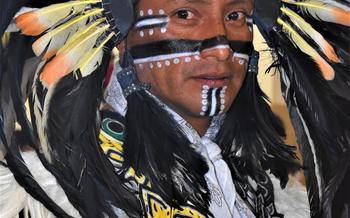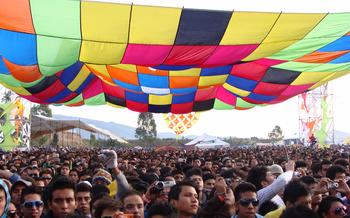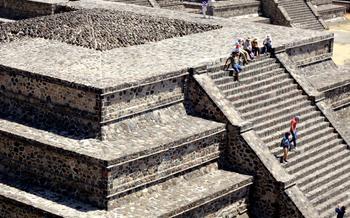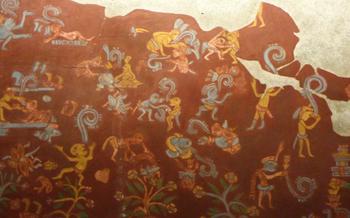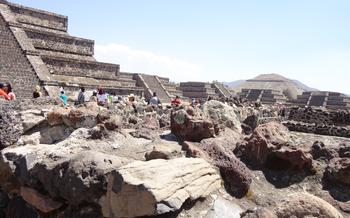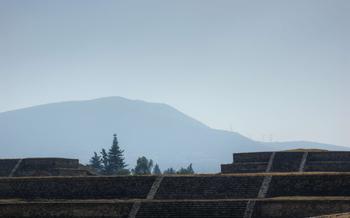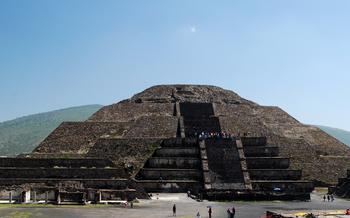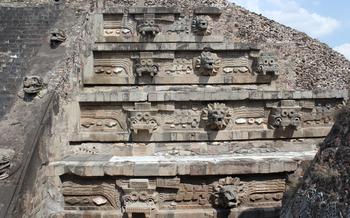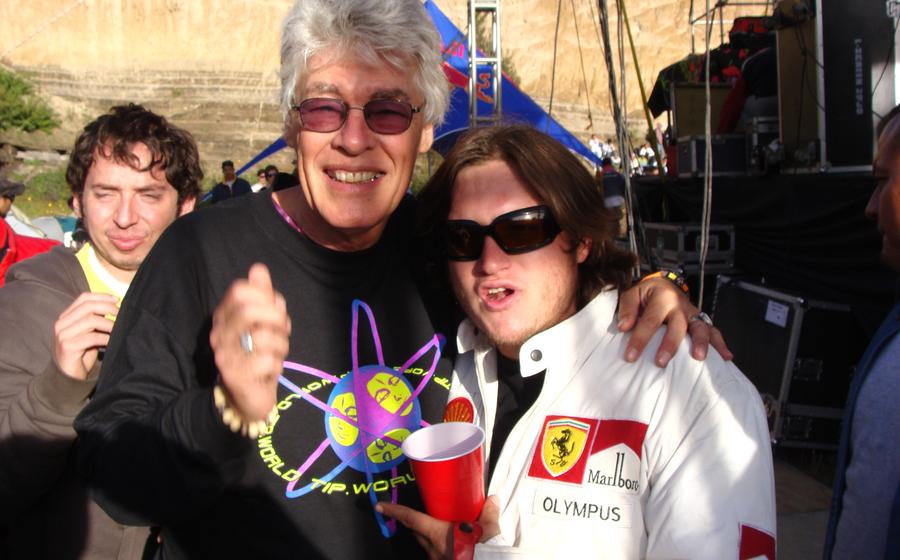
El Cedral Snakes Sanctuary
- A Monumental City of the Pre-Columbian Period
- Discovering Teotihuacan
- The El Cedral Snakes Sanctuary: A Place of Sacred Rituals
- Unraveling the Mysteries of the Sanctuary
- A Journey Through Time
- The Watery Realm
- A Place of Pilgrimage
- The Mysteries Remain
- A Living Legacy
- A World of Wonder
- Photography and Videography
- Insider Tip:
A Monumental City of the Pre-Columbian Period
The El Cedral Snakes Sanctuary is a testament to the rich cultural heritage of Teotihuacan, an ancient city that flourished in central Mexico from around 100 BC to 650 AD. The sanctuary, constructed between 200 and 450 AD, was a significant religious and cultural center within the city. Its purpose was to honor the sacred serpents revered by the Teotihuacan people, who believed that snakes possessed supernatural powers and were closely associated with water, fertility, and the underworld. The sanctuary served as a place of worship, pilgrimage, and ritual activity, reflecting the deep spiritual significance of snakes in Teotihuacan society. Archaeological evidence suggests that the sanctuary was an integral part of the city's religious and cultural life, attracting pilgrims from distant regions who sought to pay homage to the sacred serpents and participate in the rituals held within its walls.
Discovering Teotihuacan
Teotihuacan, a sprawling metropolis that once housed over 100,000 people, stands as a testament to the ingenuity and grandeur of ancient Mesoamerican civilization. Located just 40 kilometers northeast of Mexico City, this UNESCO World Heritage Site is easily accessible and offers a glimpse into a world that has long vanished.
Teotihuacan's origins remain shrouded in mystery, but it is believed to have been founded around 100 BC. The city reached its peak between the 1st and 7th centuries AD, becoming a major religious and cultural center in the region. Its influence extended far beyond its borders, as evidenced by the presence of Teotihuacan-style artifacts and architectural features throughout Mesoamerica.
Visitors to Teotihuacan are awestruck by the sheer size and scale of the city's ruins. The Avenue of the Dead, a 4-kilometer-long causeway, connects the city's main temples and palaces. The Pyramid of the Sun, the largest structure in Teotihuacan, towers over the landscape at a height of 65 meters. The Pyramid of the Moon, though smaller in size, is equally impressive and offers stunning views of the surrounding valley.
Teotihuacan is a treasure trove of archaeological wonders, and its significance in the development of Mesoamerican civilization cannot be overstated. It is a must-visit destination for anyone interested in history, culture, and the mysteries of the ancient world.
The El Cedral Snakes Sanctuary: A Place of Sacred Rituals
The El Cedral Snakes Sanctuary is a unique and awe-inspiring archaeological site located within the ancient city of Teotihuacan. Its layout, dimensions, and architectural features set it apart from other structures in the city. The sanctuary consists of a central courtyard surrounded by several platforms and chambers. The main platform, located on the north side of the courtyard, features a large staircase leading to a temple at the top. The temple is adorned with intricate carvings and sculptures depicting snakes and other symbolic motifs.
The sanctuary's symbolism and iconography revolve around the significance of snakes in Teotihuacan culture. Snakes were revered as sacred creatures associated with fertility, creation, and the underworld. The numerous serpent representations found throughout the sanctuary, including sculptures, murals, and ceramic vessels, attest to their importance in religious ceremonies and rituals.
The El Cedral Snakes Sanctuary was likely used for a variety of religious rituals and ceremonies, many of which may have involved the use of snakes. The presence of water features, such as a large basin and a series of canals, suggests that water also played a crucial role in these rituals. The sanctuary's unique features and iconography provide valuable insights into the religious and cultural beliefs of the Teotihuacan people.
Unraveling the Mysteries of the Sanctuary
Archaeological research at the El Cedral Snakes Sanctuary has employed a variety of methods to uncover its secrets. Excavations have revealed the remains of offerings, burials, and other evidence of ritual activity, providing valuable insights into the sanctuary's function. Artifact analysis has helped to identify the types of objects used in rituals, such as pottery, figurines, and jewelry. Interpretation of iconography, including the study of sculptures and murals, has shed light on the symbolism and mythology associated with the sanctuary.
Archaeologists have faced several challenges in interpreting the sanctuary's significance. The lack of written records from Teotihuacan makes it difficult to fully understand the beliefs and practices of the people who built and used the sanctuary. Additionally, the sanctuary's complex iconography and symbolism have proven difficult to decipher, leading to ongoing debates about its exact meaning and purpose.
Despite these challenges, archaeological research has made significant progress in unraveling the mysteries of the El Cedral Snakes Sanctuary. The findings from these investigations have helped to shed light on the religious beliefs and practices of the Teotihuacan people, providing valuable insights into their rich and complex culture.
A Journey Through Time
Visiting the El Cedral Snakes Sanctuary is an experience that transports visitors back in time to the ancient world of Teotihuacan. The sanctuary is open to the public, and visitors can explore its ruins and learn about its history. Hours of operation vary, so it is best to check before planning a visit. The sanctuary is located a short distance from the Pyramid of the Sun and the Pyramid of the Moon, so it is easy to combine a visit to the sanctuary with a tour of the rest of the city. Guided tours are available for those who want to learn more about the sanctuary's history and significance.
The best time to visit the sanctuary is early in the morning or late in the afternoon, when the sun is not as strong. It is also important to wear comfortable shoes, as the ground is uneven and there are many stairs to climb. Visitors should bring water and a hat to protect themselves from the sun.
In addition to the sanctuary itself, there are a number of other attractions in the area that visitors can explore. These include the Teotihuacan Museum, which houses a collection of artifacts from the city, and the Teotihuacan Botanical Garden, which features a variety of plants that were grown in the city during ancient times.
The Watery Realm
Water held a profound significance in Teotihuacan culture, and the El Cedral Snakes Sanctuary embodied this reverence for the life-giving element. Water was believed to possess sacred and purifying qualities, and its presence in the sanctuary symbolized the connection between the earthly and spiritual realms. The sanctuary's central feature, a large rectangular pool, served as a focal point for rituals and ceremonies associated with water. Offerings of precious objects, such as jade and turquoise, were often deposited in the pool, symbolizing the return of these valuable resources to the gods. Water also played a crucial role in the creation myths of Teotihuacan, where it was seen as the primordial element from which all life emerged. The sanctuary's water features thus served as a tangible reminder of the sacred origins of the universe and the importance of water in sustaining life.
A Place of Pilgrimage
In the pre-Columbian era, the El Cedral Snakes Sanctuary held a profound significance as a pilgrimage site. People from distant regions embarked on arduous journeys to Teotihuacan, driven by their faith and devotion. The sanctuary served as a beacon of spiritual enlightenment, attracting pilgrims seeking blessings, healing, or guidance from the divine.
The reasons for pilgrimage varied, but all were rooted in the belief in the sacredness of the site. Some pilgrims sought healing for physical ailments or emotional distress, believing that the sanctuary possessed a potent healing energy. Others came to seek answers to life's questions, guidance in times of uncertainty, or blessings for their families and communities.
Pilgrims would often make offerings to the gods at the sanctuary, leaving behind valuable objects such as jewelry, pottery, or textiles. These offerings were believed to express gratitude, demonstrate devotion, or seek divine favor. The act of pilgrimage itself was considered a form of worship, a way to connect with the divine and strengthen one's spiritual connection.
The presence of pilgrims from diverse regions contributed to the cultural and religious exchange in Teotihuacan. Pilgrims brought their beliefs, customs, and traditions, enriching the city's spiritual landscape. The sanctuary became a melting pot of ideas and practices, fostering a sense of unity and shared devotion among the pilgrims who gathered there.
The Mysteries Remain
Despite extensive research and archaeological discoveries, many aspects of the El Cedral Snakes Sanctuary remain shrouded in mystery. The exact purpose and significance of the sanctuary are still debated among scholars, and there are many unanswered questions surrounding its construction, use, and abandonment.
One of the biggest mysteries is the reason for the sanctuary's decline. The sanctuary was apparently abandoned around the 6th century AD, but the reasons for this are not fully understood. Some theories suggest that the decline of Teotihuacan as a political and religious center may have led to the abandonment of the sanctuary. Others suggest that environmental changes, such as droughts or floods, may have disrupted the water supply to the sanctuary, making it no longer suitable for ritual use.
Another mystery is the identity of the people who built and used the sanctuary. While it is clear that the sanctuary was constructed by the Teotihuacan people, it is not known what specific group or individuals were responsible for its construction and maintenance. The sanctuary may have been built by a ruling elite or by a specific religious order, but there is no definitive evidence to support either theory.
The El Cedral Snakes Sanctuary is a reminder that despite the advances in archaeological research, there is still much that we do not know about the ancient world. The sanctuary's enigmatic features and unanswered questions continue to fascinate and inspire researchers and visitors alike, and it remains a place of mystery and wonder.
A Living Legacy
The El Cedral Snakes Sanctuary continues to exert a profound influence on contemporary Mexican culture and identity. Its legacy extends far beyond the physical remains of the site, weaving itself into the fabric of Mexican art, literature, and music. Artists, writers, and musicians draw inspiration from the sanctuary's enigmatic iconography and symbolism, creating works that explore its cultural significance and enduring allure.
The sanctuary also plays a vital role in Mexican festivals and celebrations, particularly the Day of the Dead. During this annual observance, the spirits of the deceased are believed to return to the world of the living, and offerings are made to honor their memory. At the El Cedral Snakes Sanctuary, visitors can witness the unique blend of ancient traditions and contemporary practices as people gather to pay homage to their ancestors and to seek blessings from the spirits.
Moreover, Mexican communities are actively involved in preserving and promoting the cultural heritage of Teotihuacan, including the El Cedral Snakes Sanctuary. Through educational programs, community initiatives, and cultural events, they strive to ensure that the legacy of this ancient city remains alive and vibrant for future generations.
A World of Wonder
As I stepped through the ancient gates of the El Cedral Snakes Sanctuary, I was transported to another time and place. The air was thick with mystery and awe, and I couldn't help but feel a sense of wonder wash over me. The sanctuary's intricate carvings, towering sculptures, and vibrant murals seemed to come alive, whispering tales of a civilization long gone.
Standing in the heart of this sacred space, I was struck by its unique atmosphere. It felt as if the spirits of the ancient Teotihuacans were still present, guiding and protecting this sacred place. The energy was palpable, and I couldn't help but be humbled by the sheer power and majesty of the sanctuary.
My visit to the El Cedral Snakes Sanctuary was a truly transformative experience. It left me with a lasting impression of the incredible power and beauty of ancient Mesoamerican culture. The sanctuary is a living testament to the ingenuity, creativity, and spiritual beliefs of the Teotihuacan people, and it continues to inspire and fascinate visitors from all over the world.
Photography and Videography
The El Cedral Snakes Sanctuary is a visual feast that invites photographers and videographers to capture its unique beauty and enigmatic atmosphere. The sanctuary's well-preserved sculptures, murals, and surrounding landscape offer a variety of captivating subjects for creative expression. To capture the best shots, consider visiting during the golden hours of sunrise or sunset, when the warm light casts a magical glow on the sanctuary's features. Tripod use is recommended for crisp shots, especially in low-light conditions. Remember to be respectful of other visitors and avoid disturbing wildlife while photographing or filming. Embrace your creativity and experiment with different angles and perspectives to capture the essence of this sacred place. Consider using a wide-angle lens to capture the grandeur of the sanctuary's layout or a macro lens to focus on the intricate details of the sculptures. Share your stunning captures with the world and inspire others to embark on their own journey of discovery at the El Cedral Snakes Sanctuary.
Insider Tip:
For an unforgettable experience at the El Cedral Snakes Sanctuary, plan your visit during the early morning hours. As the sun rises, the sanctuary is bathed in a soft, golden light that illuminates the sculptures and murals in a magical way. Take advantage of the tranquility of the early morning to explore the sanctuary at your own pace, capturing stunning photographs without the crowds. Remember to bring a camera with a wide-angle lens to capture the grandeur of the site. Enjoy the serene atmosphere and let the whispers of the past guide you as you delve into the mysteries of this ancient sacred place.

